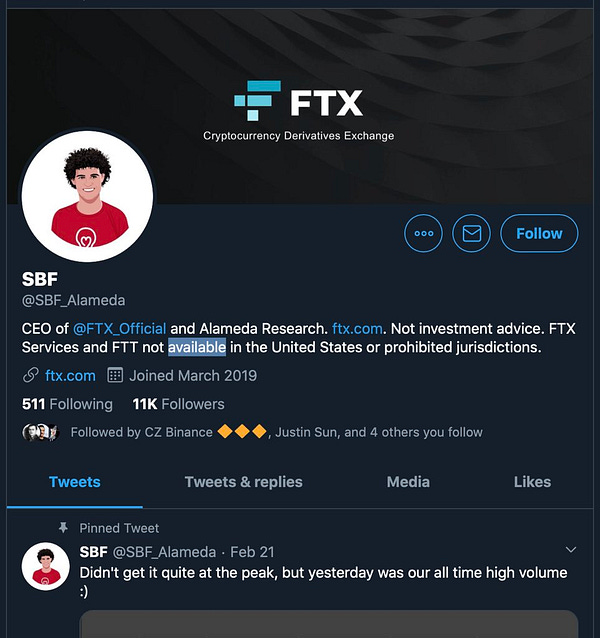July 7th, 2022: The day I understood SBF was a true supervillain
1. The crypto lenders: SBF's feeder funds
SBF was not on my radar for quite some time. He appeared in the crypto space out of nowhere and rapidly gained notoriety thanks to his unusual appearance and apparent success.
My focus was on crypto lenders such as Celsius, BlockFi, Voyager, Nexo, and a dozen other smaller ones.
These were offering yields of 8-12% on USD deposits at a time where interest rates were at 0%, and junk bonds yielded 8%.
The story was always the same: "We lend to 'reputable' institutions, nothing can go wrong."
However, when asked who those institutions were, no one wanted to give their names. "it is a trade secret," this could provide competition with an advantage...
I saw only two possibilities:
Each crypto lender is running its own Ponzi scheme, arbitrarily adjusting their rates to match each other.
There is a massive Ponzi scheme out there, and these are its feeder funds.
Because Voyager Digital was a publicly traded company in Canada, I decided to go through its SEDAR filings.
Unfortunately, its lending counterparties were only named A, B, C, and D in these filings. In December 2021 I contacted Voyager's Investor Relations to ask them for more details about their counterparties and in particular to see if they were doing business with Bitfinex or Tether.
But I only got the following response: "We do not disclose our lending partners for competitive purposes, but I can confirm it's not any of those."
2. Domino effect
In early May 2022, Terra/Luna collapsed, and its stable coin went to 0, causing massive panic in the crypto industry. Crypto lenders started to distrust each other, unknowing who had exposure to this $40bn USD wipeout.
As it turns out, Voyager Digital had lent $650m USD to 3AC one of the hedge funds that did not survive the crash.
"Luckily" for them, SBF rapidly offers to "fill" the hole by providing them a $680m USD credit line. But this credit line was more of a gimmick than a real-life buoy. Only $70m could be withdrawn per month, and that was far from being enough.
3. July 7th, 2022: secrets get exposed
On July 7th, 2022, Voyager had to file for Chapter 11 bankruptcy. This time the names of its counterparties had to be revealed.
Without surprise, the CH11 filing revealed 3AC as being one of its counterparties, but the other big one was none other than Alameda Research, SBF's very own trading firm.
That’s when it all made sense for me, Voyager was one of SBF’s feeders, and he couldn’t let it go under because that would mean paying back money he did not have.
I immediately posted a Twitter thread and raised some questions:
"Was the failed 'credit' line an attempt to keep Voyager afloat so that he does not repay this debt immediately?"
"Is SBF/Alameda/FTX really in such a good financial position, how much debt do they owe to other lenders such as BlockFi?"


4. SBF a true supervillain
From July 7th 2022 on, it was clear to me that SBF was operating the massive Ponzi scheme that was using many crypto lenders as its feeder funds, and that this money was, in all likelihood, used to fake his appearance of success.
When digging deeper, I found out that FTX was actually offering its own "Earn" product, mainly through Blockfolio, a company that FTX had acquired in August 2020.
But more shockingly, I discovered that SBF was likely gambling away customer funds on other crypto exchanges.
In February 2020, when FTX was still a dwarf and SBF only had 11K Twitter followers, he made it #1 on the weekly top losers leaderboard on Bitfinex, posting a trading loss of over $12M USD on his personal trading account.
A Twitter user (Who is a convicted Chinese money launderer) half-jokingly asked: "Are you using FTX users' funds to trade, or just your personal fund?"
SBF replied:

Knowing what we know now, it is safe to assume it weren’t his personal funds.
Following the failed bailout of Voyager, SBF desperately tried to get his hands on liquidity for his Ponzi scheme, by defrauding pretty much every one he could.
Between July and September 2022, he attempts and wins the bid to acquire Voyager Digital's assets despite the objection of the SEC.
SBF poses as a saviour, asking "Why haven't those [Voyager assets] been returned to customers yet?" in a Twitter thread.
He announces in that same thread FTX’s offer to acquire Voyager’s assets.

This acquisition offer is probably one of the most sneaky and evil moves I have ever seen in the crypto space.
The FTX proposal consisted in sending the remaining assets of Voyager users to FTX US and to provide them the "option" to withdraw them from the exchange.
SBF knew very well that Voyager's user base wasn't very tech-savvy and was unlikely to withdraw funds from FTX. It was an attempt to save himself, not Voyager customers. Had this gone through, Voyager customers would have lost the first chunk of their savings in the Voyager collapse and the remainder with FTX.
In September 2022, FTX announces it is attempting to raise $1bn USD, despite the ongoing crypto bear market.
On October 27th, 2022, just a few days before the collapse, FTX announces it is working on its own stablecoin. My best guess is that, just like BUSD (proof here) and USDT (proof here), it wouldn't have been 1:1 backed by USD.
5. SBF, a marked man
Ultimately, what brought down SBF wasn't the SEC or even the DOJ, but other "crypto bros".
When I posted my first viral tweet, CZ replied to it with "Interesting twist" and from that moment on, SBF was marked for assassination.
One week later, mid-July 2022, someone sent me the following screenshot in a DM, claiming it was from an early confidential Alameda pitch deck:
The claims made in the screenshot appeared to be so outrageous that I dismissed it as being fake. It later turns out the document was real.
In early November 2022 an anonymous source leaked Alameda's catastrophic balance sheet to CoinDesk.
A few days later, CZ gave SBF the coup de grace by selling his multimillion holdings of FTT and announcing it publicly on Twitter.









